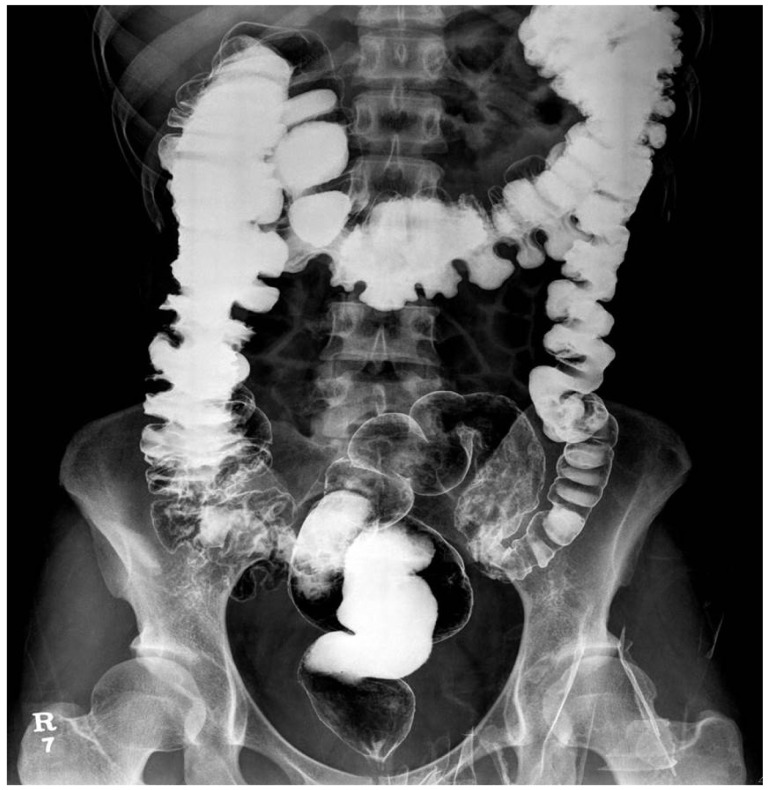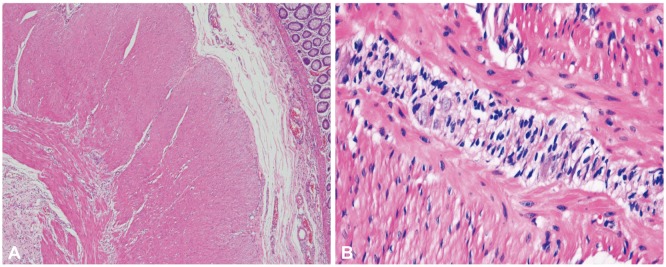Clin Endosc.
2013 Sep;46(5):591-594.
Repetitive Colonoscopic Decompression as a Bridge Therapy before Surgery in a Pregnant Patient with Chronic Intestinal Pseudo-Obstruction
- Affiliations
-
- 1Department of Internal Medicine, The Catholic University of Korea College of Medicine, Seoul, Korea. gidoc4u@gmail.com
- 2Department of General Surgery, The Catholic University of Korea College of Medicine, Seoul, Korea.
- 3Department of Pathology, The Catholic University of Korea College of Medicine, Seoul, Korea.
Abstract
- Chronic intestinal pseudo-obstruction is a rare clinical syndrome which is characterized by intestinal obstruction without occluding lesions in the intestinal lumen and pregnancy is one of the important aggravating factors. Here, we report a case of a woman with intractable intestinal pseudo-obstruction that was precipitated by pregnancy. She could not make any stool passage for more than 4 weeks until a fetal gestational age of 17 weeks was reached. However, the patient could be maintained by repetitive colonoscopic decompressions and finally total colectomy could be performed successfully at a fetal gestational age of 21 weeks.
Keyword
MeSH Terms
Figure
Reference
-
1. Faulk DL, Anuras S, Christensen J. Chronic intestinal pseudoobstruction. Gastroenterology. 1978; 74(5 Pt 1):922–931. PMID: 346432.
Article2. Luckas M, Buckett W. Acute colonic pseudo-obstruction in the obstetric patient. Br J Hosp Med. 1997; 57:378–381. PMID: 9274662.3. ACOG Committee on Obstetric Practice. ACOG Committee Opinion. Number 299, September 2004 (replaces No. 158, September 1995). Guidelines for diagnostic imaging during pregnancy. Obstet Gynecol. 2004; 104:647–651. PMID: 15339791.4. Ponec RJ, Saunders MD, Kimmey MB. Neostigmine for the treatment of acute colonic pseudo-obstruction. N Engl J Med. 1999; 341:137–141. PMID: 10403850.5. Lyford G, Foxx-Orenstein A. Chronic intestinal pseudoobstruction. Curr Treat Options Gastroenterol. 2004; 7:317–325. PMID: 15238207.
Article6. Geller A, Petersen BT, Gostout CJ. Endoscopic decompression for acu te colonic pseudo-obstruction. Gastrointest Endosc. 1996; 44:144–150. PMID: 8858319.7. Classen M, Tytgat GN, Lightdale CL, et al. Gastroenterological Endoscopy. 2nd ed. New York: Thieme;2010.8. Cappell MS. Risks versus benefits of gastrointestinal endoscopy during pregnancy. Nat Rev Gastroenterol Hepatol. 2011; 8:610–634. PMID: 21970872.
Article9. De Giorgio R, Sarnelli G, Corinaldesi R, et al. Advances in our underst anding of the pathology of chronic intestinal pseudo-obstruction. Gut. 2004; 53:1549–1552. PMID: 15479666.
- Full Text Links
- Actions
-
Cited
- CITED
-
- Close
- Share
- Similar articles
-
- Chronic Idiopathic Intestinal Pseudo-obstruction in Adult: A Case Report with a Clinical Analysis of Other Reported Cases in Korean Literature
- A Case of Megacystis Associated with Primary Chronic Intestinal Pseudoobstruction
- A case of chronic intestinal pseudo-obstruction syndrome
- A Case of Chronic Idiopathic Pseudo-Obstruction Caused by a Degenerative
- Chronic idiopathic intestinal pseudo-obstruction syndrome in childhood






